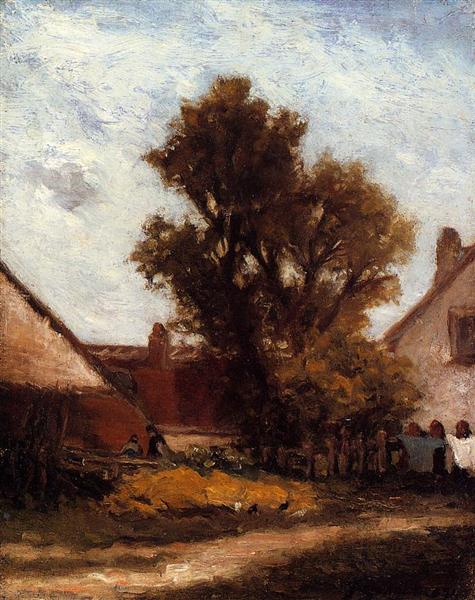Description
Paul Gauguin's painting "Tree in the Farmyard", painted in 1874, is a work that, although it may seem simple in its subject matter, contains a complex interplay of elements that reveal the author's stylistic and emotional search in his early years. The work is a paradigmatic example of the way in which Gauguin begins to abandon the precepts of realism, moving towards a more personal and symbolic representation of reality.
In this painting, Gauguin presents us with a view of the rural space that surrounded him, specifically the farm he frequently visited. The tree that dominates the centre of the composition is a symbol of life and growth, articulating country life through its lushness. The branches of the tree reach towards the sky, almost as if trying to touch a world beyond the earthly, suggesting a longing to transcend the everyday. Its occupying presence in the work suggests both stability and permanence in a changing environment, a trait that will be recurrent in Gauguin's later works.
The use of color in this piece is notable. Gauguin uses a rich and vibrant palette, dominated by earthy greens and browns, complemented by touches of white and blue that provide cool hues. This choice of color avoids saturation while at the same time giving depth and character to the scene, exuding an atmosphere that could be considered both calming and introspective. While the painting can be interpreted as a naturalistic depiction, the expressive use of color introduces an almost dreamlike element that invites the viewer to contemplate beyond mere observation.
The composition of the work is essentially balanced, with the tree as the focal point that guides the viewer's gaze towards the surroundings that appear to be both a home and a familiar environment. However, although the area envelops us, the absence of human figures gives the work a quality of solitude or introspection, echoing Gauguin's interest in the connection between man and nature. In the farm yard, nature seems to speak in its own language, a theme that would resonate throughout Gauguin's artistic career.
It is also interesting to consider that this work was created at a time when Gauguin was still an artist emulating Impressionism. Although he radically moved away from the movement later on, exploring more symbolic and primitivist styles, in Tree in the Farmyard we can still see traces of Impressionism in his attention to light and the atmosphere of the environment. This sets the stage for his future evolution and his unique style that he will explore in works such as Where Do We Come From? What Are We? Where Are We Going?, where the connection with the spiritual and the immaterial becomes even more prominent.
This work by Gauguin, though perhaps accidentally overshadowed by his later achievements, offers a fascinating window into his creative process and his relationship with the rural environment of France. The picturesque depiction of the tree, along with the masterful use of color and balanced composition, not only captures a moment in time, but also foreshadows the deep personal and symbolic quest that would characterize his work as he progressed in his career. Thus, “Tree in the Farmyard” stands as a testament to the beginnings of an evolution toward an art that would go far beyond mere visual representation.
KUADROS ©, a famous painting on your wall.
Hand-made oil painting reproductions, with the quality of professional artists and the distinctive seal of KUADROS ©.
Painting reproduction service with satisfaction guarantee. If you are not completely satisfied with the replica of your painting, we will refund 100% of your money.

